Shinzo
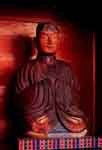 Three wooden Shinto statues (shinzo) depicting
the Sanzan Shujin (the three chief deities of the Kumano
Three Grand Shrines) can be found at the Kumano Hayatama
Grand Shrine.
Three wooden Shinto statues (shinzo) depicting
the Sanzan Shujin (the three chief deities of the Kumano
Three Grand Shrines) can be found at the Kumano Hayatama
Grand Shrine. 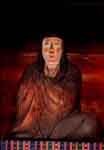 These shinzo
are unique because they take the form of a man in the
prime of life whereas most of shinzo take the form of an
old man.
These shinzo
are unique because they take the form of a man in the
prime of life whereas most of shinzo take the form of an
old man.
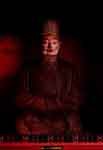 The names of
the three chief deities are; 'Ketsumimikono
Ookami'(Susano no Mikoto) representing the Hongu Grand
Shrine, 'Kumano Hayatama no Ookami' (Izanagi no Mikoto)
representing the Hayatama Grand Shrine, and 'Fusumi no
Kami' (Izanami no Mikoto) representing the Nachi Grand
Shrine. All three Grand Shrines celebrate the existence
of these three chief deities. The statues shown here are
housed in the Hayatama Grand Shrine and were made in the
Heian Era in 8th century A.D.
The names of
the three chief deities are; 'Ketsumimikono
Ookami'(Susano no Mikoto) representing the Hongu Grand
Shrine, 'Kumano Hayatama no Ookami' (Izanagi no Mikoto)
representing the Hayatama Grand Shrine, and 'Fusumi no
Kami' (Izanami no Mikoto) representing the Nachi Grand
Shrine. All three Grand Shrines celebrate the existence
of these three chief deities. The statues shown here are
housed in the Hayatama Grand Shrine and were made in the
Heian Era in 8th century A.D.
to the top
 The story of 'Oguri Hangan and Terutehime' is a
special story that symbolizes healing in Kumano.
According to legend Oguri Hangan's wife Terutehime, and
many other pilgrims in turns, carried his disease-ridden
body in a shabby old wooden cart all the way from Edo
(now Tokyo) to Hongu to soak in the local hotsprings.
After absorbing the healing powers of the Yunomune
Hotsprings (Tsuboyu), Oguri Hangan recovered from his
disease, as if dutifully responding to his wife's wish to
see him healed even at the risk of her own life.
'Kurumazuka' is the place where they are said to have
buried their cart which they no longer needed.
The story of 'Oguri Hangan and Terutehime' is a
special story that symbolizes healing in Kumano.
According to legend Oguri Hangan's wife Terutehime, and
many other pilgrims in turns, carried his disease-ridden
body in a shabby old wooden cart all the way from Edo
(now Tokyo) to Hongu to soak in the local hotsprings.
After absorbing the healing powers of the Yunomune
Hotsprings (Tsuboyu), Oguri Hangan recovered from his
disease, as if dutifully responding to his wife's wish to
see him healed even at the risk of her own life.
'Kurumazuka' is the place where they are said to have
buried their cart which they no longer needed. to the top
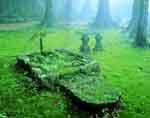 After climbing the mountain behind Mt. Nachi,
you will find Myohozan Amidaji Temple, which is also
called Nyonin Koya (a sacred mountain temple where women
could enter unlike the real Mt. Koya where they strictly
could not). Ojo Shonin, mentioned in Japanese historical
records, is a monk who undertook severe practices in
Myohozan Amidaji Temple above the Nachi Waterfall. His
last practice was his final self-sacrifice. He ate
nothing except pine needles, wore paper clothes, sat on
the firewood facing the west and burned himself. A little
altar marking the place where he sacrificed himself can
be found behind Myohozan Amidaji Temple.
After climbing the mountain behind Mt. Nachi,
you will find Myohozan Amidaji Temple, which is also
called Nyonin Koya (a sacred mountain temple where women
could enter unlike the real Mt. Koya where they strictly
could not). Ojo Shonin, mentioned in Japanese historical
records, is a monk who undertook severe practices in
Myohozan Amidaji Temple above the Nachi Waterfall. His
last practice was his final self-sacrifice. He ate
nothing except pine needles, wore paper clothes, sat on
the firewood facing the west and burned himself. A little
altar marking the place where he sacrificed himself can
be found behind Myohozan Amidaji Temple. to the top
to the top
 Senju Kannon, in the Buddhist tradition, is the
'formless saviour deity'. The statue here symbolizes a
deity with one thousand hands and one thousand eyes which
is meant to indicate that this deity is a saviour which
comes in an infinite variety of forms. This Senshu Kannon
is the main Buddha statue of Fudarakusanji Temple in
Hamanomiya, Nachikatsuura Town. Fudarakusanji Temple is
famous for 'Fudaraku Tokai' where the main monks of this
temple set out for Kannon Jodo (The Pure Land of the
Formless Saviour Deity) across the sea.
Senju Kannon, in the Buddhist tradition, is the
'formless saviour deity'. The statue here symbolizes a
deity with one thousand hands and one thousand eyes which
is meant to indicate that this deity is a saviour which
comes in an infinite variety of forms. This Senshu Kannon
is the main Buddha statue of Fudarakusanji Temple in
Hamanomiya, Nachikatsuura Town. Fudarakusanji Temple is
famous for 'Fudaraku Tokai' where the main monks of this
temple set out for Kannon Jodo (The Pure Land of the
Formless Saviour Deity) across the sea. to the top
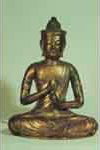 This is a statue of MahaVairochana (the
Universal Buddha) of the Tendai sect of esoteric
Buddhism. It is located in the Seigantoji Temple near
Nachi Falls. This temple is the first temple in the
'Pilgrimage of 33 Temples of Kannon Bodhisattvas in
Kansai'. 'MahaVairochana' is called Dainichi Nyorai in
Japanese and is the Buddhist deity expressive of the
universal energy of creation. Dainichi Nyorai manifests
itself in two ways. One is called Taizokai (the world of
the universal womb) which is the energy of procreation.
The other is Kongokai (the world of the universal
diamond) which is the energy of sacred geometry. The
mudra (hand position) in this photo symbolizes the energy
of Kongokai.
This is a statue of MahaVairochana (the
Universal Buddha) of the Tendai sect of esoteric
Buddhism. It is located in the Seigantoji Temple near
Nachi Falls. This temple is the first temple in the
'Pilgrimage of 33 Temples of Kannon Bodhisattvas in
Kansai'. 'MahaVairochana' is called Dainichi Nyorai in
Japanese and is the Buddhist deity expressive of the
universal energy of creation. Dainichi Nyorai manifests
itself in two ways. One is called Taizokai (the world of
the universal womb) which is the energy of procreation.
The other is Kongokai (the world of the universal
diamond) which is the energy of sacred geometry. The
mudra (hand position) in this photo symbolizes the energy
of Kongokai. to the top
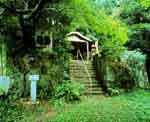 Hojo Masako was called Ama Shogun (female
shogun) because she was the wife of Minamotono Yoritomo
who started the Kamakura Government (the end of the 12th
century). This monument is believed to have been built by
her when she made a pilgrimage to Kumano. Kamakura and
Kumano had a deep connection because Yoritomo's aunt,
Torii no Zenni was married to Kumano no Betto (the
Governor of Kumano). At that time Kumano had a powerful
navy. Therefore, Kamakura felt it to be strategic to be
close to Kumano. There is a little pass called Nisakagoe
on the way to Mt. Nachi from Hamanomiya. Right after this
pass lies this monument built by Ama Shogun. Masako was
the one who wielded the real power after Yoritomo's
death. This monument was built by Ama Shogun for Yoritomo
on her pilgrimage to Kumano.
Hojo Masako was called Ama Shogun (female
shogun) because she was the wife of Minamotono Yoritomo
who started the Kamakura Government (the end of the 12th
century). This monument is believed to have been built by
her when she made a pilgrimage to Kumano. Kamakura and
Kumano had a deep connection because Yoritomo's aunt,
Torii no Zenni was married to Kumano no Betto (the
Governor of Kumano). At that time Kumano had a powerful
navy. Therefore, Kamakura felt it to be strategic to be
close to Kumano. There is a little pass called Nisakagoe
on the way to Mt. Nachi from Hamanomiya. Right after this
pass lies this monument built by Ama Shogun. Masako was
the one who wielded the real power after Yoritomo's
death. This monument was built by Ama Shogun for Yoritomo
on her pilgrimage to Kumano. to the top
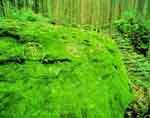 Echizen Toge
Pass', the hardest part of the Kumano Kodo Old Road
between Nachi and Hongu, is followed by a long and steep
descent. This road leads to the ruins of an old inn.
There you can find a big rock near the road. It is called
Warouzaishi (Warouza Stone) and is said to have been
where the gods of Kumano gathered to pleasantly chat.
There are three Bonji (Sanskrit characters) engraved on
it. Each character is symbolic of one of the three
Buddhist deities of Kumano Three Grand Shrines. The
middle one is pronounced 'bai' indicating Yakushi Nyorai
(the deity of healing) and is connected to the Hayatama
Grand Shrine. The left character is pronounced 'sa'
indicating Kannon Bosatsu (the formless saviour deity)
which is connected to the Nachi Grand Shrine. The right
character is pronounced 'kiriku' indicating Amida Nyorai
(the deity of resurrection) which is connected to the
Hongu Grand Shrine. That means that we can be saved in
the past, present, and future through the deities of the
three Kumano Grand Shrines.
Echizen Toge
Pass', the hardest part of the Kumano Kodo Old Road
between Nachi and Hongu, is followed by a long and steep
descent. This road leads to the ruins of an old inn.
There you can find a big rock near the road. It is called
Warouzaishi (Warouza Stone) and is said to have been
where the gods of Kumano gathered to pleasantly chat.
There are three Bonji (Sanskrit characters) engraved on
it. Each character is symbolic of one of the three
Buddhist deities of Kumano Three Grand Shrines. The
middle one is pronounced 'bai' indicating Yakushi Nyorai
(the deity of healing) and is connected to the Hayatama
Grand Shrine. The left character is pronounced 'sa'
indicating Kannon Bosatsu (the formless saviour deity)
which is connected to the Nachi Grand Shrine. The right
character is pronounced 'kiriku' indicating Amida Nyorai
(the deity of resurrection) which is connected to the
Hongu Grand Shrine. That means that we can be saved in
the past, present, and future through the deities of the
three Kumano Grand Shrines. to the top
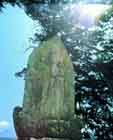 Koshinto-a stone statue in Enmeiji Temple in
Ugui, Nachikatsuura Town- was built by the locals to ward
off evil spirits. According to the Chinese calendar and
the Taoist I Ching, Koshin is a day of bad luck. The
locals perform a yearly festival to ward the bad luck
associated with Koshin.
Koshinto-a stone statue in Enmeiji Temple in
Ugui, Nachikatsuura Town- was built by the locals to ward
off evil spirits. According to the Chinese calendar and
the Taoist I Ching, Koshin is a day of bad luck. The
locals perform a yearly festival to ward the bad luck
associated with Koshin. to the top
 This photo (above right) shows the talisman
called 'Karasu Go-ou Shinpu. The characters are written
here in the form of crows. The Three-Legged Crow was
considered to be the messenger of the deities of the
Kumano 3 Grand Shrines. This talisman is a signification
of a promise between the deities of Kumano and human
beings, and also between people themselves. According to
legend, if someone broke their promise one crow would die
at one of the Kumano Grand Shrines. This Talisman was
given to pilgrims who came to Kumano and was also
distributed throughout Japan by the Kumano Bikuni (Kumano
missionary nuns). This photo shows the one belonging to
the Kumano Hayatama Grand Shrine.
This photo (above right) shows the talisman
called 'Karasu Go-ou Shinpu. The characters are written
here in the form of crows. The Three-Legged Crow was
considered to be the messenger of the deities of the
Kumano 3 Grand Shrines. This talisman is a signification
of a promise between the deities of Kumano and human
beings, and also between people themselves. According to
legend, if someone broke their promise one crow would die
at one of the Kumano Grand Shrines. This Talisman was
given to pilgrims who came to Kumano and was also
distributed throughout Japan by the Kumano Bikuni (Kumano
missionary nuns). This photo shows the one belonging to
the Kumano Hayatama Grand Shrine. to the top
- The Okyo and Rosetsu Museum
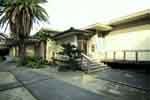 This is an art museum in the town
of Kushimoto. It is known for its large
collection of works by Maruyama Okyo and his
disciple, Rosetsu.This art museum lies within the
precincts of the Muryoji Temple, the famous
temple of the Rinzai Tofukuji sect.
This is an art museum in the town
of Kushimoto. It is known for its large
collection of works by Maruyama Okyo and his
disciple, Rosetsu.This art museum lies within the
precincts of the Muryoji Temple, the famous
temple of the Rinzai Tofukuji sect.  The connection between this temple and the two
painters started when a monk called Gukai asked
Maruyama Okyo to paint murals for the new temple
building after a tidal wave had washed away the
original building in the Edo Era. Okyo had his
best disciple, Nagasawa Rosetsu bring a painting
to this temple. Rosetsu decided to stay in
Kushimoto for a long time and produced a lot of
art works which can now be seen in this museum
along with the works of Okyo and other artists.
The connection between this temple and the two
painters started when a monk called Gukai asked
Maruyama Okyo to paint murals for the new temple
building after a tidal wave had washed away the
original building in the Edo Era. Okyo had his
best disciple, Nagasawa Rosetsu bring a painting
to this temple. Rosetsu decided to stay in
Kushimoto for a long time and produced a lot of
art works which can now be seen in this museum
along with the works of Okyo and other artists.
to the top- Ryuko Zu (Dragon and Tiger Murals)
 This is 'The
Picture of a Dragon' by Rosetsu. 'The Tiger
Picture' and 'The Dragon Picture' were painted by
Nagasawa Rosetsu and are designated as national
cultural treasures. They form a pair of fusuma
paper screen paintings whose powerful brush touch
evokes an inspiring atmosphere.
This is 'The
Picture of a Dragon' by Rosetsu. 'The Tiger
Picture' and 'The Dragon Picture' were painted by
Nagasawa Rosetsu and are designated as national
cultural treasures. They form a pair of fusuma
paper screen paintings whose powerful brush touch
evokes an inspiring atmosphere.
to the top
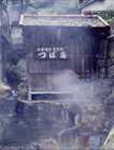 Yakushi Nyorai is the main deity of the ‘Tokoji Temple’
in the village of ‘Yunomine Onsen’, where the hotspring water is
famous for its ‘wild and natural’ flavour. The existence of this
healing deity in the region of Kumano is highly symbolic and is linked to
the notion of Kumano as a land of healing and rebirth. A well-known legend
also exists about a man called Oguri Hangan who recovered from a terminal
disease by bathing in the waters of this hotspring--Tuboyu.
Yakushi Nyorai is the main deity of the ‘Tokoji Temple’
in the village of ‘Yunomine Onsen’, where the hotspring water is
famous for its ‘wild and natural’ flavour. The existence of this
healing deity in the region of Kumano is highly symbolic and is linked to
the notion of Kumano as a land of healing and rebirth. A well-known legend
also exists about a man called Oguri Hangan who recovered from a terminal
disease by bathing in the waters of this hotspring--Tuboyu.